was there a transitional Rifle bridging of the gap from Germanic Jaeger rifles to what we now call the Kentucky rifle. or is that just fantasy? if so what did they look like?
-
Friends, our 2nd Amendment rights are always under attack and the NRA has been a constant for decades in helping fight that fight.
We have partnered with the NRA to offer you a discount on membership and Muzzleloading Forum gets a small percentage too of each membership, so you are supporting both the NRA and us.
Use this link to sign up please; https://membership.nra.org/recruiters/join/XR045103
You are using an out of date browser. It may not display this or other websites correctly.
You should upgrade or use an alternative browser.
You should upgrade or use an alternative browser.
was there a "transitional Rifle"
- Thread starter olskool
- Start date

Help Support Muzzleloading Forum:
This site may earn a commission from merchant affiliate
links, including eBay, Amazon, and others.
excess650
50 Cal.
- Joined
- Nov 25, 2009
- Messages
- 1,671
- Reaction score
- 639
Can we start with these two survivors?
http://www.erickettenburg.com/edward-marshalls-rifle.html
https://scavengeology.com/the-rca-1...ntlock-smooth-rifle-with-an-exciting-history/
Look at the "sister rifle" to RCA 19 as well because its shorter in length.
Take a look in Rifles of Colonial America and you'll see numerous early rifles that don't qualify as the fully evolved longrifle, whether you choose to call it Kentucky or Pennsylvania. Look at the guns in the Moravian rifle books, or the early George Shroyer in Kindig's Thoughts of the Kentucky Rifle in its Golden Age ( others in that book as well).
http://www.erickettenburg.com/edward-marshalls-rifle.html
https://scavengeology.com/the-rca-1...ntlock-smooth-rifle-with-an-exciting-history/
Look at the "sister rifle" to RCA 19 as well because its shorter in length.
Take a look in Rifles of Colonial America and you'll see numerous early rifles that don't qualify as the fully evolved longrifle, whether you choose to call it Kentucky or Pennsylvania. Look at the guns in the Moravian rifle books, or the early George Shroyer in Kindig's Thoughts of the Kentucky Rifle in its Golden Age ( others in that book as well).
Last edited:
excess650
50 Cal.
- Joined
- Nov 25, 2009
- Messages
- 1,671
- Reaction score
- 639
The John Schreit rifle was take to England as a Rev War trophy, and came back to the US around 1970. Its signed and dated 1761, so the earliest known with both signature and date.
https://www.google.com/search?sxsrf...gQICBAC&biw=1600&bih=775#imgrc=fIG1lWLBzTJn5M
https://www.google.com/search?sxsrf...gQICBAC&biw=1600&bih=775#imgrc=fIG1lWLBzTJn5M
Wildrangeringreen
40 Cal
The idea that there were ever distinct phases of rifle styling is purely a modern collector's idea (understandable, categorizing things makes it easier to talk about them). You still saw Baroque-style carvings (supposedly "extinct" by the 1750's in most places) and engravings late into the 1700's, and you occasionally saw them even later. Many early American guns were made with imported barrels and locks, and what was available was affected by trends in the various sources for those parts in Europe (some gun makers made only long guns in Europe, some made only short guns, and some made a mix). Many early gunmakers in the Americas were trained in Europe, and brought a lot of ideas about what makes a "proper gun" from what ever workshop(s) they apprenticed in.
Many guns, especially from very small shops that didn't really keep a stock of guns on hand, made every one to what the customers wanted, so you see guns with all sorts of styling and specs. If a customer had an older piece that they wanted updated or remade, they often used as many of the old parts they could.
You combine all that, with a tendency to use imported fowlers from Britain and France in the north; and Britain and Spain in the south, and you can see where all of it came together to make the fad known as "The American Longrifle" (which, in their truest form, only lasted for about 30-40 years, basically 2 working generations of gunmakers, before going back to stuff more similar to what many Europeans where using).
Many guns, especially from very small shops that didn't really keep a stock of guns on hand, made every one to what the customers wanted, so you see guns with all sorts of styling and specs. If a customer had an older piece that they wanted updated or remade, they often used as many of the old parts they could.
You combine all that, with a tendency to use imported fowlers from Britain and France in the north; and Britain and Spain in the south, and you can see where all of it came together to make the fad known as "The American Longrifle" (which, in their truest form, only lasted for about 30-40 years, basically 2 working generations of gunmakers, before going back to stuff more similar to what many Europeans where using).
- Joined
- May 6, 2014
- Messages
- 17,433
- Reaction score
- 16,435
Caspar Wistar was importing (actually smuggling) high end rifles, rifle barrels and locks from Germany into Philadelphia in the mid/late 1740's. As to the length of rifle barrels, he wrote the commonly most preferred length was about "three and a half feet" or about 42," even then.
Gus
Gus
Excellent answers above. If you are interested in rifles stocked here between 1750 and 1775, there are several we can discuss.
- Joined
- May 6, 2014
- Messages
- 17,433
- Reaction score
- 16,435
Excellent answers above. If you are interested in rifles stocked here between 1750 and 1775, there are several we can discuss.
Can't speak for anyone else, BUT I would LOVE to read about Rifles in RCA Volumes I or II (or other places) stocked here during the FIW time period, as I'm still a bit hazy on them.
Gus
Have built a couple rifles based on a recognized transitional rifle called the Edward Marshal Indian Walk rifle of 1748 . ........oldwood
- Joined
- Sep 24, 2008
- Messages
- 606
- Reaction score
- 845
Still wish I had built the Edward Marshall rifle instead of my Jaeger. Don’t tell my Jaeger I said that! Hindsight is 20/20.
Actually, it was only a "transition" here in The Colonies. Pro-USA rifle historians think the American Longrifle highly unique. It was a Germanic answer to North America.was there a transitional Rifle bridging of the gap from Germanic Jaeger rifles to what we now call the Kentucky rifle. or is that just fantasy? if so what did they look like?
The Germans had "long rifles" of calibers less than .58 still, when the Jaeger style came over. In fact, if you look very hard, you will notice that you would have an easier time loading the Germanic jaeger..., on horseback. The short barrel and heavy ball were great in the thick forests of Germany where "old growth" had been cut down over the centuries for charcoal for blacksmithing.
Conditions were different here in North America. Lead was not as prevalent, and neither was powder. Old growth forests provide much more shielding to the game animal than the Germanic forests did, so the heavy ball was never going to smash its way to the target. The riflemen here had to thread the shot between trees, and the longer barrel the Germans already knew gave a longer sight plane. The smaller caliber would save on lead and powder and still get the job done.
LD
plmeek
40 Cal.
The idea of a "transitional rifle" has been around for a long time. Early writers such as Henry Kauffman and Joe Kindig, Jr. both wrote about it in 1960. The concept was that there was an evolution or linear progression from the short barrel Jaeger (30" or less) to the American long rifle (barrels over 40" long).
Then George Shumway published pictures of the Edward Marshall rifle in Rifles of Colonial America in 1980 and John Bivins wrote about the Edward Marshall rifle in Muzzle Blasts in August of 1986 and a number of people thought it fit perfectly what one would expect the "transitional rifle" to be like. Other rifles have turned up that fit within that "transitional" barrel length range.
The trouble with the concept, as pointed out by Wildrangeringreen and Artificer, is that long barreled rifles and individual long barrels were being imported from Germany and used on American made rifles in the time period (1730s) that the evolution was supposedly taking place. So if there was a "transition" occurring, it was happening in Germany and not America. (See Moravian Gunmaking II by Robert Lienemann, page 66.)
The poster rifle for the idea of a "transitional rifle", namely the Edward Marshall rifle, is made with one of these imported barrels from Rothenberg, Germany and is so marked on the barrel, or is a restocking of a rifle that was originally made in Germany. In any event, it is not an example of an American "transitional rifle" because the barrel isn't American.
I think the early writers and collectors of Kentucky rifles made a mistake in assuming all German rifles in the early 1700s were short barreled. Research and better awareness of what was actually being made in Germany and what was being imported into America has brought a realization that a long barrel on a rifle was not an American invention or innovation after all.
Then George Shumway published pictures of the Edward Marshall rifle in Rifles of Colonial America in 1980 and John Bivins wrote about the Edward Marshall rifle in Muzzle Blasts in August of 1986 and a number of people thought it fit perfectly what one would expect the "transitional rifle" to be like. Other rifles have turned up that fit within that "transitional" barrel length range.
The trouble with the concept, as pointed out by Wildrangeringreen and Artificer, is that long barreled rifles and individual long barrels were being imported from Germany and used on American made rifles in the time period (1730s) that the evolution was supposedly taking place. So if there was a "transition" occurring, it was happening in Germany and not America. (See Moravian Gunmaking II by Robert Lienemann, page 66.)
The poster rifle for the idea of a "transitional rifle", namely the Edward Marshall rifle, is made with one of these imported barrels from Rothenberg, Germany and is so marked on the barrel, or is a restocking of a rifle that was originally made in Germany. In any event, it is not an example of an American "transitional rifle" because the barrel isn't American.
I think the early writers and collectors of Kentucky rifles made a mistake in assuming all German rifles in the early 1700s were short barreled. Research and better awareness of what was actually being made in Germany and what was being imported into America has brought a realization that a long barrel on a rifle was not an American invention or innovation after all.
- Joined
- Nov 26, 2005
- Messages
- 5,224
- Reaction score
- 10,884
Hi,
This debate is really fraught because most barrels and hardware used on colonial and pre Rev War rifles were imported from England and Europe. Yes barrels were made in the colonies but remember the British frowned on value added industries in the colonies. The colonies supplied raw materials to England and received finished goods in return. German gunsmiths occasionally made long barreled rifles. Perhaps the American innovation was a smaller rifle bore more economical on powder and lead but given greater striking force by a long barrel. Anyway, import manifests by Wister and others show that longer barrels were more popular in America even in the 1730s. Here is my version of the Edward Marshall rifle. It is a pretty close copy and shows a moderate barrel length (>37") but big bore. Not sure if it should be called transitional.

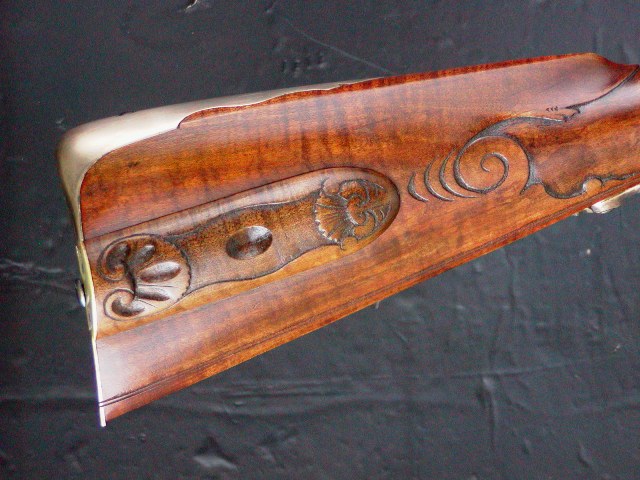


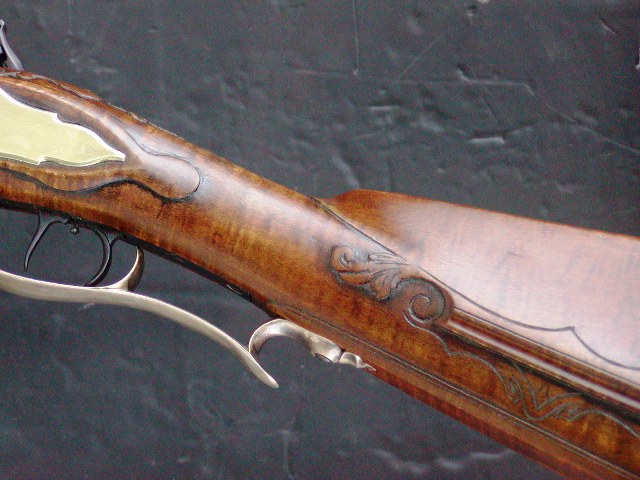
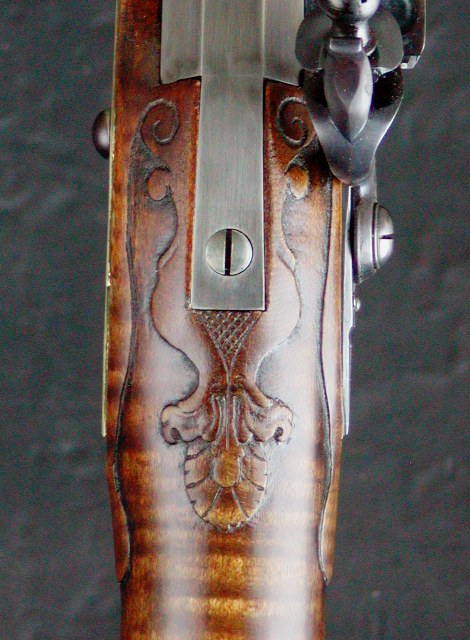
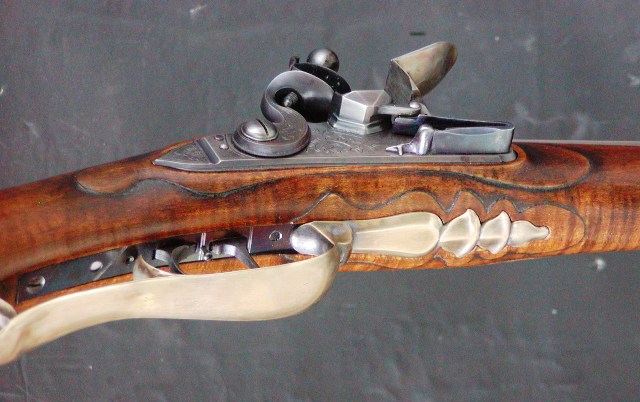
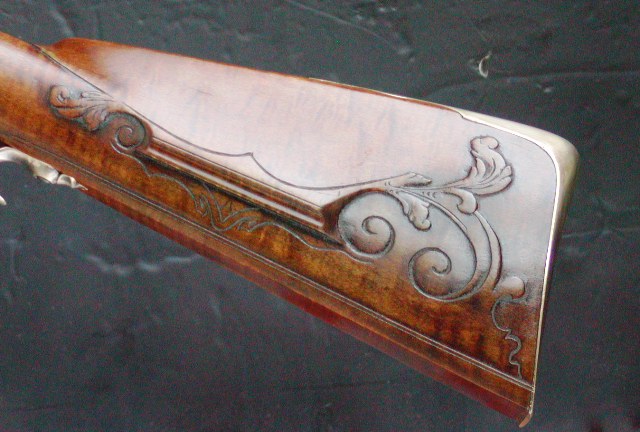
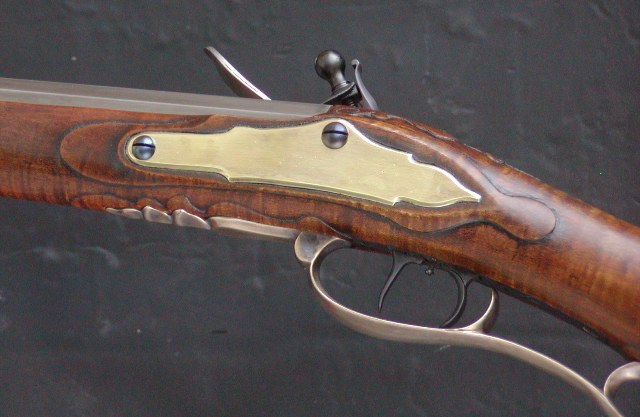
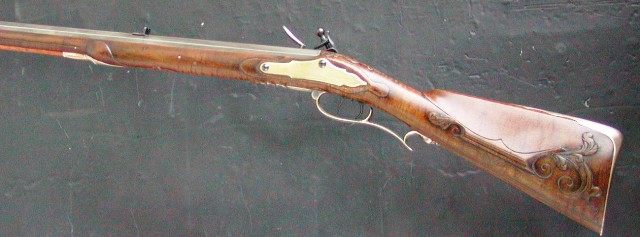
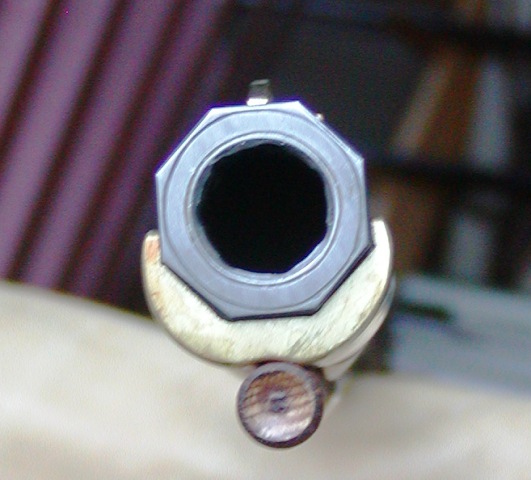
dave
This debate is really fraught because most barrels and hardware used on colonial and pre Rev War rifles were imported from England and Europe. Yes barrels were made in the colonies but remember the British frowned on value added industries in the colonies. The colonies supplied raw materials to England and received finished goods in return. German gunsmiths occasionally made long barreled rifles. Perhaps the American innovation was a smaller rifle bore more economical on powder and lead but given greater striking force by a long barrel. Anyway, import manifests by Wister and others show that longer barrels were more popular in America even in the 1730s. Here is my version of the Edward Marshall rifle. It is a pretty close copy and shows a moderate barrel length (>37") but big bore. Not sure if it should be called transitional.











dave
Let’s start with the Tulip Rifle. Shumway wrote a Muzzle Blasts article about it February 1988 but this was after he finished Rifles of Colonial America.Can't speak for anyone else, BUT I would LOVE to read about Rifles in RCA Volumes I or II (or other places) stocked here during the FIW time period, as I'm still a bit hazy on them.
Gus
Stock: maple
Barrel: .60 caliber, rifled, swamped, 35 and 5/8” long
Buttplate width: 2 and 7/32”
Lock: English, mid 1700s round faced
Shumway considered this to have been made in America in the mid 1700s - not the third quarter of the 18th century. So, seems he meant 1750 plus or minus. It has a rounded cheekpiece and an integrated carving resembling a tulip.
let’s discuss what you see as “early”, what you see as “American”, and anything about it that would make it as late as 1770. The lock is not the first lock the gun has had. I took the photos. .










- Joined
- Sep 24, 2008
- Messages
- 606
- Reaction score
- 845
Dave_person, that is by far my favorite rifle I’ve ever seen this forum since I’ve been a member. Wow! Elegant yet brutishly all business. The profile is old world class. Thanks for the beautiful photos. I will save them to my phone.
This "new to me " , info on longer imported European barrels is interesting. A friend and I discussed building , "long barreled Jaeger rifles" , like 30 yrs. ago and thought they would be very popular , if we built them. And so they were. I still have a few to build in my scratch build pile. Folks especially liked 36" to 38" octagon to round barrels for big game hunting rifles. Me too. .....................oldwood
Dave.........Thanks for the wonderful close up photos of the Tulip Rifle. The butt plate repair is interesting. Couple of years ago I remember being temporarily stumped about how to repair an old butt plate with this very injury. Didn't realize my attempt was historically correct until viewing your pics........Thanks again.....oldwood
I’m Thinking it was 1711 that the first rifle maker shows up on tax rolls in the colonies
The idea that there were ever distinct phases of rifle styling is purely a modern collector's idea (understandable, categorizing things makes it easier to talk about them).
Very much like the way we treat decades. We tend to talk about the '50s, the '80s, the '90s, etc. as though they were all completely distinct and self contained; however, as we all know, each decade actually blends in with the one before and the one after. For example, based upon the decades in which I've lived, the late '70s were fairly indistinguishable from the early '80, and the late '80s weren't too different from the early '90s, and so on. Barring the occasional discovery or invention that changes things radically in a very short time, everything is in gradual but constant transition. Not to mention things that fall out of and back into favor or style across many decades.
- Joined
- Nov 26, 2005
- Messages
- 5,224
- Reaction score
- 10,884
Hi Rich,
Where is that rifle? I did not see Shumway's article on it. Did he describe its provenance?
dave
Where is that rifle? I did not see Shumway's article on it. Did he describe its provenance?
dave
Similar threads
- Replies
- 2
- Views
- 231
- Replies
- 5
- Views
- 635
- Replies
- 4
- Views
- 674
Latest posts
-
-
-
-
FOR SALE Original Mountain Man / Frontier Pistol
- Latest: Relic shooter
-
-
-
-
FOR SALE Kuchenreuter pistol ... great pics and info
- Latest: No second place
-





